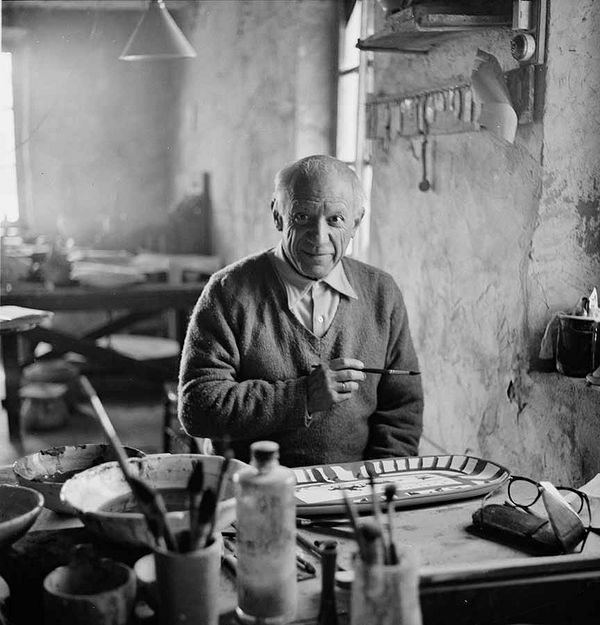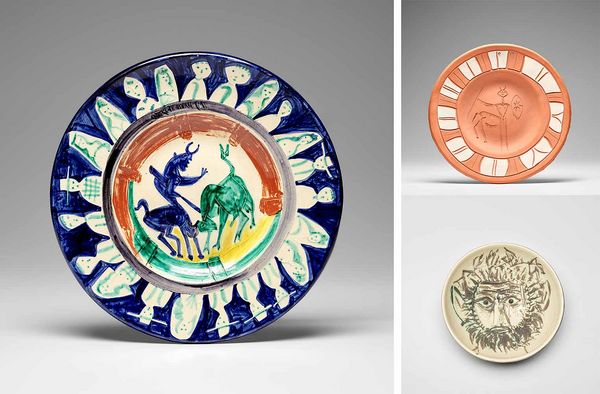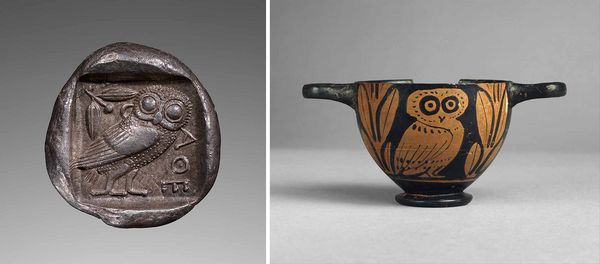Pablo Picasso works on the plate Picador et torero at the Madoura pottery in Vallauris, 23rd March 1953. Photo: Edward Quinn, © edwardquinn.com.
To me there is no past or future in art. If a work of art cannot live always in the present it must not be considered at all. The art of the [ancient] Greeks, of the Egyptians, of the great painters who lived in other times, is not an art of the past; perhaps it is more alive today than it ever was.
– Pablo Picasso
For two decades, Pablo Picasso made the ancient village of Vallauris, near Antibes, his home. Famed for its local red clay and production of ceramics since antiquity, Vallauris captivated Picasso and inspired him to take up the ancient craft. In the summer of 1946, whilst he was holidaying in nearby Golfe-Juan with his partner, Françoise Gilot, he visited the village for the first time to see their acclaimed annual ceramics exhibition, hosted by the Madoura pottery studio. He met Georges and Suzanne Ramié, the proprietors of Madoura, and ignited a creative partnership that would last until Picasso’s death. Invigorated by the technical potentials of the ceramic medium, Picasso and Gilot soon moved to Vallauris. Picasso established a permanent studio at Madoura and, between 1947 and 1971, produced over 3500 unique and editioned works. There, in the picturesque Mediterranean village, Picasso discovered an avenue to indulge in his lifelong admiration for the arts of antiquity.
Despite never having visited Greece, Picasso had become familiar with ancient art as a student, drawing from plaster casts and often visiting the Louvre. In addition, a trip to Italy with his friend Jean Cocteau in 1917 had granted Picasso the opportunity to directly encounter the treasures of ancient Rome. Antiquity infused itself into his artistic productions, stylistically presented in the adaptation of classical compositions, mythological subject matters, and sculptural nude forms. In 1922, his relationship with antiquity further developed after having been invited to design the set for a production of Cocteau’s adaption of Sophocles’ Antigone (441 BC), in Paris. Throughout his long career, the philosophy, mythology and iconography of ancient Greece continually provided Picasso with a vocabulary of limitless possibilities.
They are doing this here since millennia […] It is here where I am at home.
– Pablo Picasso describing Madoura pottery studio
The ancient Greeks were the original pioneers of pottery. They invented an array of techniques and styles, many of which remain in use to this day. Picasso became deeply fascinated with the age-old medium and whilst making ceramics adopted multiple traditional techniques, such as applying slips, oxides, glazes and enamel. In his quintessential manner, he experimented: mixing materials, using his hands, and devising tools for imprinting designs – playing with the possibilities of the material. In addition, the unpredictable nature of the firing process, which differed vastly from painting a canvas, became a source of inspiration for Picasso. He embraced the anticipated and uncontrollable transformations that took place within the kiln.
Clockwise from left: Pablo Picasso, Corrida aux personnages (Bullfight with Figures) (A.R. 104), 1950. Centaure (Centaur) (A.R. 102), 1950. Visage de faune (Faun's Face) (A.R. 256), 1955. Pablo Picasso - Paper and Clay: Online Auction.
The mythology of antiquity was an unwavering source of inspiration for Picasso. From fauns and centaurs to minotaurs, an assortment of mythological characters populate his ceramics. As he pushed art to new visual territory, breaking away from tradition, he simultaneously looked to the past, utilizing mythological figures and their symbolic gravitas. He drew great inspiration from Ovid’s magnum opus, Metamorphoses (8 CE), and its reoccurring theme of humans transforming into animals. The philosophical underpinnings of Ovid’s poem investigate the polarity so often used to frame humanity's relationship with animals and, in particular, the tension between the hunter and the hunted. This is poignantly visualised in Picasso’s Corrida aux personnages (Bullfight with Figures) (lot 8), in which the matador has been transformed into a minotaur. Half-bull, half-human, the Dionysian creature symbolizes the conflicting impulses of humanity’s inner psyche. Much like the ancient Greeks, Picasso persistently probed the polarity of good and evil that pervades through human nature. The metamorphosis and violent scene depicted in Corrida aux personnages (Bullfight with Figures) lead us to question the distinction, or lack thereof, between man and beast. The bull motif recurs throughout Picasso’s oeuvre, often considered to be an embodiment of the artist himself and, by extension, mankind’s split personalities: conscience and civility versus an underlying animal instinct that begets lust and violence.
Upper left: Oinochoe, last quarter of the 6th century BCE, The Metropolitan Museum of Art, New York. Image: © The Metropolitan Museum of Art, New York, Gift of Samuel G. Ward, 1875, 75.2.24. Lower left: Terracotta miniature oinochoe (jug), ca. 325–300 BCE, The Metropolitan Museum of Art, New York. Image: © The Metropolitan Museum of Art, New York, Rogers Fund, 1911, 11.212.42. Right: Lots 17, 16, and 18, from Pablo Picasso - Paper and Clay: Online Auction.
Much like the ancient Greeks, Picasso saw his ceramics not only as art but also as utilitarian objects. Vallauris was a Roman-era hub for amphorae production and exportation, and many of Picasso’s pitchers and vases closely echo their designs. Yan bandeau noir (lot 17) and Yan soleil (lot 18), for instance, feature the long slender bodies and high curved handles found in Attic amphorae. There are also close parallels in the surface design, where black paint is applied in a manner that appears to reveal the baked clay below. Similarly, the pitchers’ striking pinched lips mimic the trefoil form found in ancient Greek jugs called oenochoae. This elegant yet functional design aspect creates the ideal form for pouring wine and olive oil in true Mediterranean style.
I would like them to be found in every market, so that, in a village in Brittany or elsewhere, one might see a woman going to the fountain to fetch water with one of my jars.
– Pablo Picasso
Pablo Picasso, Chouette (Wood-Owl) (A.R. 605), 1969. Pablo Picasso - Paper and Clay: Online Auction.
Owls were prolific in the visual culture of ancient Greece, owing to their role as the animal attribute of the goddess Athena. They featured prominently on Attic coinage and on many decorated vases, particularly skyphoi. Picasso loved birds of all shapes and sizes, but it was a serendipitous encounter with a wounded owl in 1946 that inspired his adoration of this particular fowl. Françoise Gilot chronicled the event in her memoir, writing that on discovering the owl, “one of his claws had been injured. We bandaged it and it gradually healed. We bought a cage for him and when we returned to Paris, we brought him back with us and put him in the kitchen with the canaries, the pigeons and the turtledoves.” As well as symbolizing wisdom, mystique, and introspection, owls carried even greater meaning in the South of France, as they were the historic symbol of Antibes. Combining classical motifs that echo the ancient world, local symbols linking the work to the southern French locale, and innovative, bold designs, Picasso’s avian ceramic works are emblematic of his unique and innovative artistic vision.
Left: Coin of Athens, 475–465 B.C., J. Paul Getty Museum, Los Angeles. Image: Digital image courtesy of Getty’s Open Content Program. Right: Terracotta skyphos, mid 5th century B.C., The Metropolitan Museum of Art, New York. Image: © The Metropolitan Museum of Art, New York, Rogers Fund, 1941, 41.162.100.
Picasso’s enduring affinity for antiquity is most palpable in his ceramic creations made at the Madoura atelier. In the village of Vallauris, where pottery had been produced for eons, the artist drew inspiration from the Classical tradition, inspired by the forms, mythology and philosophy of ancient Greece. Through these ceramics, Picasso’s dialogue with the iconography of the ancient civilization marries simplicity and function with the innovation of his iconic visual language. This reimagining of the Classical culminates in a distinctly modern ode to this craft of bygone eras.
Pablo Picasso – Paper and Clay: Online Auction
Opening 12:00pm BST, 26 October 2023
Closing 4:00pm GMT, 2 November 2023
Discover More from Editions London >
Recommended Reading




